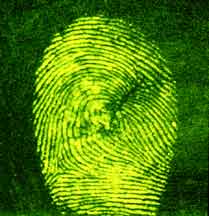Fingerprints can be left on two contrasting surfaces: Non-Porous and Porous
Non- Porous
Prints are easily left on non-porous surfaces such as glass, wood, and painted areas. In order to recover those prints, the method of dusting is normally required.
An investigator dusting a wooden door, a non-porous surface, to find fingerprints.
Dusting is a common method to find fingerprints on non-porous surfaces. It starts by the area where the print is located is lightly dusted with a dusting brush and the corresponding colored powder, which depends on the background shade/coloring. Then the dust is lifted with tape and set against a contrasting background to make the print easily visible.
Black Dust: White or Light colored Surfaces
Grey or White Dust: Dark Surfaces
Fluorescent Dust: Multi-Colored Surfaces
Magnetic Dust: Leather or Rough Surfaces
Fingerprint found using fluorescent powder.
Porous
Prints left on fiber-like surfaces such as paper and cloth are called porous. In order to recover these prints, the use of chemicals is necessary. The various chemical methods for recovering fingerprints are Iodine Fuming, Ninhydrin, Silver Nitrate, and Super Glue Fuming.
Hand print found on clothing, a porous surface.
Iodine Fuming—The material that needs to be fingerprinted is placed into an enclosed cabinet along with iodine crystals. The crystals are heated and soon turn into a gaseous vapor. The vapor then causes the prints to appear.
Ninhydrin- This method starts by spraying the chemical onto the surface of the material via an aerosol can. After a few hours, the prints begin to become visual. This process can be accelerated if the prints are heated up after application of the chemical.
Silver Nitrate- Mostly used as a last resort method when both Iodine Fuming and Silver Nitrate have failed. The silver nitrate is sprayed onto the surface of the porous material and is then left to dry. It is later exposed to ultraviolet light, which exposes the prints and allows examination.
Super Glue Fuming (also used on non-porous materials)-Super glue is placed on cotton and is treated with sodium hydroxide. The fumes are then created by heating the treated cotton.The fumes and object are placed inside a heated chamber for up to six hours and the fumes adhere to the print, exposing it.
 |
| Example of a fuming chamber |


No comments:
Post a Comment